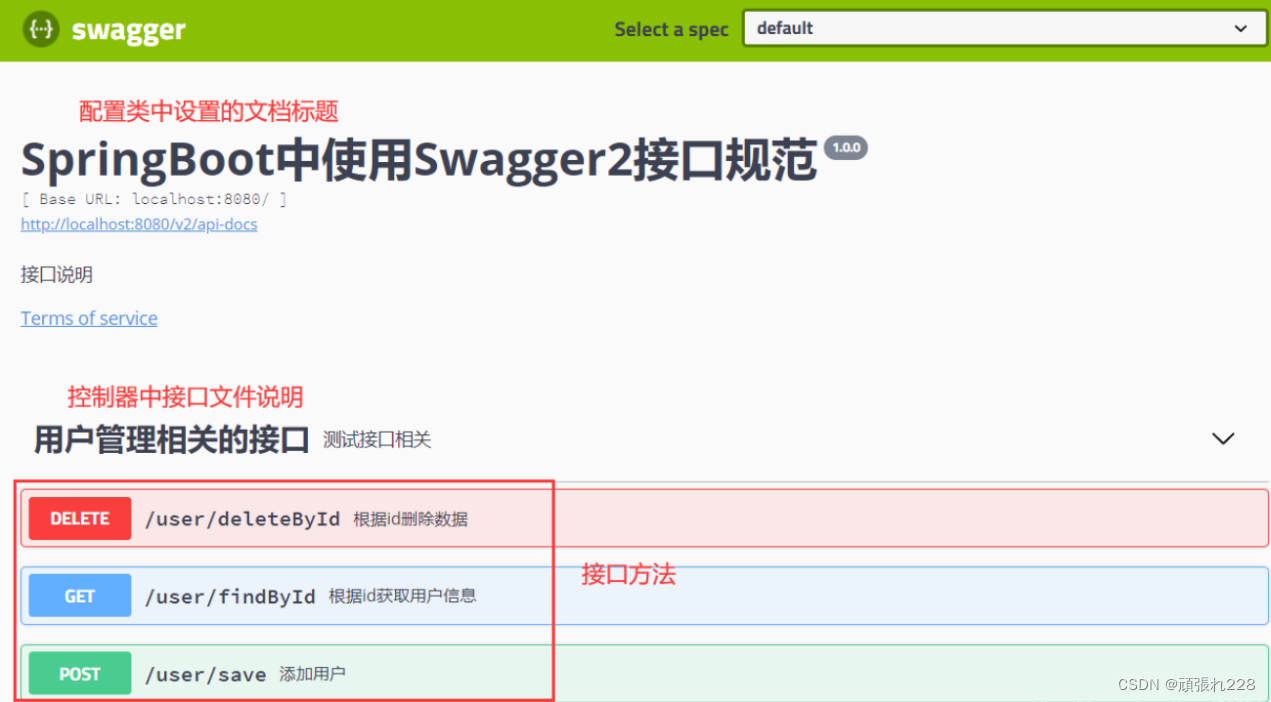1、新建SpringBoot项目,导入swagger依赖
<dependency>
<groupId>io.springfox</groupId>
<artifactId>springfox-swagger-ui</artifactId>
<version>2.9.2</version>
</dependency>
<dependency>
<groupId>io.springfox</groupId>
<artifactId>springfox-swagger2</artifactId>
<version>2.9.2</version>
</dependency>2、编写swagger的配置文件
import org.springframework.beans.factory.annotation.Value;
import org.springframework.context.annotation.Bean;
import org.springframework.context.annotation.Configuration;
import springfox.documentation.builders.ApiInfoBuilder;
import springfox.documentation.builders.PathSelectors;
import springfox.documentation.builders.RequestHandlerSelectors;
import springfox.documentation.service.ApiInfo;
import springfox.documentation.spi.DocumentationType;
import springfox.documentation.spring.web.plugins.Docket;
import springfox.documentation.swagger2.annotations.EnableSwagger2;
/**
1. swagger配置类
*/
@Configuration
@EnableSwagger2
public class SwaggerConfig {
@Bean
public Docket createRestApi() {
return new Docket(DocumentationType.SWAGGER_2)
.apiInfo(apiInfo())
//是否开启 (true 开启 false隐藏。生产环境建议隐藏)
//.enable(false)
.select()
//扫描的路径包,设置basePackage会将包下的所有被@Api标记类的所有方法作为api
.apis(RequestHandlerSelectors.basePackage("com.mcy.springbootswagger.controller"))
//指定路径处理PathSelectors.any()代表所有的路径
.paths(PathSelectors.any())
.build();
}
private ApiInfo apiInfo() {
return new ApiInfoBuilder()
//设置文档标题(API名称)
.title("SpringBoot中使用Swagger2接口规范")
//文档描述
.description("接口说明")
//服务条款URL
.termsOfServiceUrl("http://localhost:8080/")
//版本号
.version("1.0.0")
.build();
}
}3.@EnableSwagger2的作用是启用Swagger2相关功能
import com.mcy.springbootswagger.User.User;
import com.mcy.springbootswagger.service.UserService;
import io.swagger.annotations.Api;
import io.swagger.annotations.ApiImplicitParam;
import io.swagger.annotations.ApiOperation;
import org.springframework.beans.factory.annotation.Autowired;
import org.springframework.web.bind.annotation.*;
@RestController
@RequestMapping("/user")
//说明接口文件
@Api(value = "测试接口", tags = "用户管理相关的接口", description = "用户测试接口")
public class UserController {
@Autowired
private UserService userService;
/**
* 保存数据
* @param user
* @return
*/
@PostMapping(value = "/save")
//方法参数说明,name参数名;value参数说明,备注;dataType参数类型;required 是否必传;defaultValue 默认值
@ApiImplicitParam(name = "user", value = "新增用户数据")
//说明是什么方法(可以理解为方法注释)
@ApiOperation(value = "添加用户", notes = "添加用户")
public String saveUser(User user){
userService.save(user);
return "保存成功";
}
/**
* 根据id查询用户
* @param id
* @return
*/
@GetMapping(value = "findById")
@ApiOperation(value = "根据id获取用户信息", notes = "根据id查询用户信息")
public User getUser(Integer id){
return userService.findById(id);
}
@DeleteMapping(value = "deleteById")
@ApiOperation(value = "根据id删除数据", notes = "删除用户")
public String delete(Integer id){
userService.deleteById(id);
return "删除成功";
}
}运行项目,输入http://localhost:8080/swagger-ui.html访问Swagger页面,页面如下:

Swagger使用的注解及其说明:
| @Api | 用在类上,说明该类的作用 |
|---|---|
| @ApiOperation | 注解来给API增加方法说明 |
| @ApiParam | 定义在参数上 |
| @ApiResponses | 用于表示一组响应 |
| @ApiResponse | 用在@ApiResponses中,一般用于表达一个错误的响应信息 l code:数字,例如400 l message:信息,例如"请求参数没填好" l response:抛出异常的类 |
| @ApiModel | 描述一个Model的信息(一般用在请求参数无法使用@ApiImplicitParam注解进行描述的时候) l @ApiModelProperty:描述一个model的属性 |
| @ApiImplicitParams | 用在方法上包含一组参数说明 |
| @ApiImplicitParam | 用来注解来给方法入参增加说明 |























 845
845

 被折叠的 条评论
为什么被折叠?
被折叠的 条评论
为什么被折叠?








